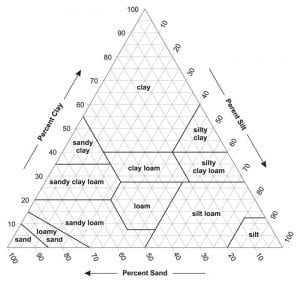by Bruno Pedreira, extension agronomist, Parsons, KS.
Producing hay is more than a simple agricultural activity. It requires soil, forage, equipment, and weather knowledge to put-up high-quality hay. The fundamental process behind a bale of hay is the harnessing of the sun’s energy, water, and the supply of plant nutrients from the soil to produce plant biomass. There is not much producers can control regarding the sun’s energy availability but there are a couple of actions that can be taken to improve plant nutrition.
The first step in knowing the hayfield yield potential is to understand more about the base of the system: the soil. Starting with the soil sample, besides the chemical information, we need to know the texture and if we are working a sandy, silty, or clay soil. There are 12 basic texture classes (Figure 1) (Ditzler, C., Scheffe, K. and Monger, 2017). Soil texture can be identified by a lab test or by searching NRCS soil survey maps, available freely through the Web Soil Survey (websoillsurvey.nrcs.usda.gov).

Sandy soils do not have the capacity to hold nutrients that clay or loam soils have and building organic matter in sandy soil is always more difficult than in clay soil. For these reasons, the nutrient availability in a sandy hayfield will have a different dynamic than a clay hayfield. Thus, based on the known texture and nutrient availability, a fertility program can be designed to achieve the system’s goals.
Is the goal for this hayfield to produce hay to be used on farm or to be sold? If the hay will be used on farm, define the system forage budget and a production goals for the field that considers the tradeoffs between quality and quantity for the intended animal use. If the hay will be sold, is the buyer more interested in quality or price? Nitrogen input can be increased to get a higher crude protein hay, but somebody needs to recognize it’s value and pay for it. The trick here is to demonstrate that an 11% crude protein hay can reach animals’ nutritional requirements that a 6% crude protein hay will not. Thus, by buying a higher crude protein hay, the supplement expense will be reduced.
Forage yield and quality can be strongly affected by soil fertility (Lamond, 2002), and the greater the hay quality and yield, the greater the nutrient removal from a hayfield. Total removal can be estimated based on the amount of forage harvested multiplied by the nutrient removed in each ton of forage. Removals from 3.2 to 12 lb/ton of P2O5, and from 8.7 to 60 lb/ton of K2O can be expected from different forage crops (Table 1) (Leikam et al., 2003), which need to be considered in the fertility program to reach the system’s goal.
Table 1. P and K removals from forage crops based on as fed forage yield.
| Crop | P2O5 (lb/ton) | K2O (lb/ton) |
| Alfalfa | 12 | 60 |
| Red clover | 12 | 50 |
| Bermudagrass | 12 | 40 |
| Bromegrass | 12 | 40 |
| Tall Fescue | 12 | 40 |
| Corn silage | 3.2 | 8.7 |
| Sorghum silage | 3.2 | 8.7 |
Replenishing the nutrients removed every year will help maintain the soil fertility levels, otherwise year after year the nutrients will be exported from the hayfield and forage production will decline. Moreover, a hayfield deficient in macronutrients (N, P, and K) will not allow forage plants to grow to their full potential, giving weeds the chance to take over. By knowing the soil characteristics (texture and chemical), understanding the goals for each field, and monitoring yield, we will be able to set a fertility program to maintain the hayfield soil nutrition and production, assuring a long-term forage system.
In 2022, with high fertilizer prices, there is no chance to have an economically efficient fertility program without a soil test report. The focus should be on efficiency. Target lime, or fertilizer application to pastures with the lowest values in the soil test because they will have greater potential for a profitable response. The main goal for 2022 will be to grow needed forage when and where you need it.
References
Ditzler, C., Scheffe, K. and Monger, H. C. (eds.). (2017). Soil Survey Manual. In USDA Handbook 18. Government Printing Office, Washington, D.C. (Issue 18).
Lamond, R. (2002). Nutrient management for cool season grasses. Better Crops, 86(1), 1–2.
Leikam, D. F., Lamond, R. A., & Mengel, D. B. (2003). Soil test interpretations and fertilizer recommendations. https://bookstore.ksre.ksu.edu/pubs/mf2586.pdf